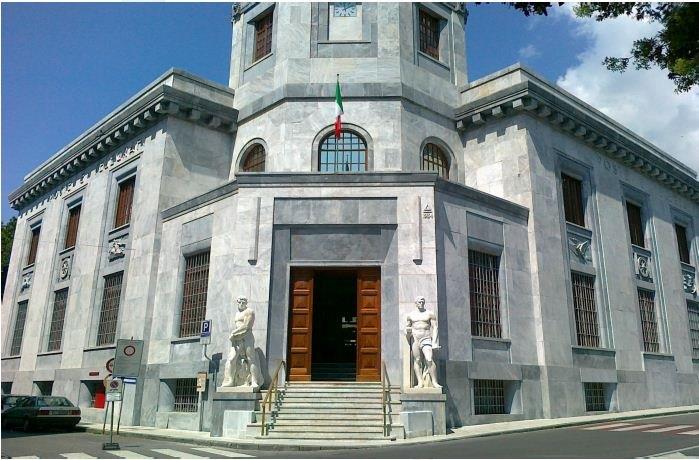La Casa Del Balilla Posted by Serena on Oct 25, 2018 in Uncategorized
Sabato scorso siamo andati a Carrara per visitare un’interessante mostra d’arte intitolata ‘Colori e Forme del Lavoro’.
Last Saturday we went to Carrara to visit an interesting art exhibition entitled ‘Colours and Forms of Work’.
Erano quadri e sculture della fine dell’Ottocento – inizi Novecento, che rappresentano gente comune nella fatica del lavoro. Fra le altre c’erano opere di Telemaco Signorini, Giovanni Fattori, Giuseppe Pellizza Da Volpedo e Giacomo Balla.
They were paintings and sculptures from the end of the 19th century and the beginning of the 20th century, depicting common folks toiling at work. Amongst them were works by Telemaco Signorini, Giovanni Fattori, Giuseppe Pellizza Da Volpedo and Giacomo Balla.
Uscendo dal palazzo dove si teneva la mostra, siamo passati davanti ad un imponente edificio chiaramente di architettura fascista. Infatti sopra al portale d’ingresso, posto sull’angolo della costruzione, si leggeva ‘Casa del Balilla’; poi ancora, sotto a questo, ‘Anno VII E.F.’
Coming out of the building where the exhibition was held, we passed in front of an imposing edifice which was clearly in the Fascist style of architecture. In fact above the entrance door, positioned on the corner of the building, you could read ‘Casa del Balilla’ (Fascist’s Youth House); then below that, ‘Year VII F.E.’
Geoff era incuriosito dalla strana dicitura:
“Che cavolo vuol dire?”
“Significa Anno settimo dell’Era Fascista” gli ho spiegato.
“Boh?!” mi ha risposto lui.
Geoff was intrigued by the strange writing:
“What the devil does that mean?”
“It means The Seventh Year of The Fascist Era” I explained to him.
“Boh?!” he replied to me.
“Durante il fascismo, Mussolini impose una doppia datazione, quella tradizionale scritta in numeri arabi, e accanto quella fascista scritta in numeri romani, che partiva dalla marcia su Roma, l’inizio del potere Fascista, avvenuta nell’ottobre del 1922. Perciò questa Casa Del Balilla deve essere stata costruita nel 1929” gli ho precisato.
“During the fascist era, Mussolini imposed a double form of indicating dates, the traditional one written in Arab numerals, and alongside it the fascist one written in Roman numerals, beginning from the March on Rome which took place in October 1922 and marked the beginning of fascist power. Therefore this Casa del Balilla must have been built in 1929” I clarified for him.
Geoff era sempre più incuriosito da questo fatto, così gli ho raccontato un ricordo legato alla datazione fascista. “Mi ricordo che quand’ero bambina mia nonna aveva ancora un quaderno di scuola di mia mamma, e un giorno ce l’ha fatto vedere. Era il quaderno dei temi, e ogni tema cominciava con la doppia data, per esempio: 21 ottobre 1928, VI. Peccato non avercelo più, chissà che fine avrà fatto!”
Geoff was increasingly curious about this, so I shared with him a memory which was connected to the fascist dating system. “I remember that when I was a child my grandmother still had one of my mother’s exercise books, and one day she showed it to us. It was her composition book, and each composition started with the double date, for example: 21th October 1928, VI (6th year of the Fascist era). What a pity I don’t have it anymore, who knows what became of it!”

Build vocabulary, practice pronunciation, and more with Transparent Language Online. Available anytime, anywhere, on any device.





Comments:
Elizabeth K Vaughn:
I love these blogs!
You can see that a lot of work and thought has been put into them and we really appreciate all of it.
Thank you.
Serena:
@Elizabeth K Vaughn Grazie!
Michael La Bombarda:
I’m making an early New Year’s Resolution to read and print out your blog every time it appears. It’s such a treasure to have this blog available. Thank you and keep up the informative articles.
Serena:
@Michael La Bombarda Grazie!
Alison Brown:
I am so loving these blogs!
Thank you for the time and effort that goes into them.
I am learning something new in each one: be it cultural or grammatical.
Thanks again!
Alison
Serena:
@Alison Brown Grazie Alison!
Nini Rukmini:
thanks for sharing.
Serena:
@Nini Rukmini Non c’è di che!
Cindy Bigras:
I famosi macchiaioli! Sono dei pittori non molto conosciuti qui negli USA ma sono stupendi e (secondo me) alla pari degli impressionisti francesi.